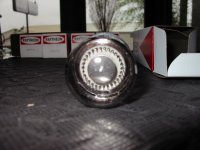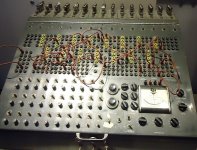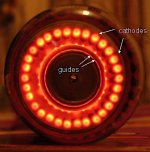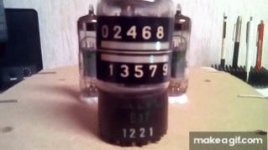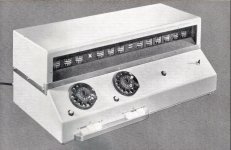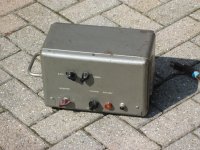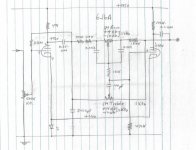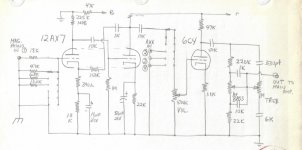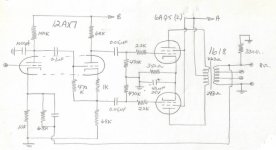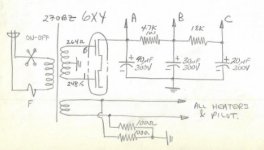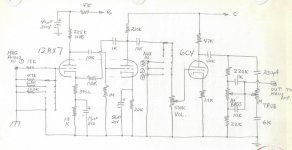I got plenty of 5687, 5963, 5964, 5965, 5844, 6463, 7044, and 7119. No 6530's.
<snip>
The 5687, 6463, 7044 and 7119 are all computer tubes with higher emission and plate current capabilities.
I spent much of 5 years going through large boxes full of random tubes, and testing them for use in audio circuits. ALL of the tubes I mention in this post work fine in audio applications, so I saved a box full of each.
George,
I don't know too much from the other tubes you mentioned, but the 6463 resembles the 12BH7A per the data, the curves and the ratings. So, why not? One needs to observe the pinout, though, as the 6463 has got it's cathode and grid pins reversed w.r.t 12BH7, 12AX7 etc.
Best regards!
George,
do you still have a bunch of the 5964? That would solve the supposed lifetime problem of the 6N15P/6J6...
do you still have a bunch of the 5964? That would solve the supposed lifetime problem of the 6N15P/6J6...
A Dekatron counting tube would save you a lot of tubes.
Vintage Raytheon 6476A Computer Dekatron Counter Tube CK6476A NOS NIB | eBay
Search Ebay for "computer tube" and all kinds of interesting stuff comes up.
5844 and 5964 appear to be a computer rated 6J6. Cheap tube.
Vintage Raytheon 6476A Computer Dekatron Counter Tube CK6476A NOS NIB | eBay
Search Ebay for "computer tube" and all kinds of interesting stuff comes up.
5844 and 5964 appear to be a computer rated 6J6. Cheap tube.
Attachments
Last edited:
Heathkit tube analog computer.
6JH8 and related beam deflection tubes can do analog multiplication. (and division too, with a N Fdbk circuit attached)
An X-Y scope attached to an analog computer could provide dynamic output display.
And for the ultimate in Spice circuit analysis of tube circuits: A software mod to one of the PC tube curve tracers (uTracer, eTracer, ...) would allow one to use a real tube as the tube model in Spice circuit analysis. Spice would call the tube model, and the model would set the curve tracer up to do a point test of the tube at the given node voltages. Sending back the measured currents to the model software.
6JH8 and related beam deflection tubes can do analog multiplication. (and division too, with a N Fdbk circuit attached)
An X-Y scope attached to an analog computer could provide dynamic output display.
And for the ultimate in Spice circuit analysis of tube circuits: A software mod to one of the PC tube curve tracers (uTracer, eTracer, ...) would allow one to use a real tube as the tube model in Spice circuit analysis. Spice would call the tube model, and the model would set the curve tracer up to do a point test of the tube at the given node voltages. Sending back the measured currents to the model software.
Attachments
Last edited:
but the 6463 resembles the 12BH7A per the data
The 6463, 7119 and 7044 all make good audio amp stages. All have enough grunt to be used as a driver or headphone output tube. Audio Note UK used the 7044 in some of their amp designs like their "Ongaku."
do you still have a bunch of the 5964?
I'll have to look in my warehouse. I don't remember saving many of them, since I was only interested in audio applications at the time and I did have a large collection of 6J6 / 6101 tubes. I may still have those, but getting a large box of loose tubes to Switzerland is probably the bigger problem.
A Dekatron counting tube would save you a lot of tubes.
I had several hundred pounds of those magnetic monsters. They were disposed of at the original warehouse cleanout site since many were broken and they have little use today. The derelict warehouse site was near Orlando, so I took several pickup truck loads of tubes directly to Stan at ESRC and traded them for store credit. The physically broken or badly corroded stuff went to the local trash dump. How many hydrogen or mercury thyratrons does one need for building tube amps? Ditto 10 KV, 1 A rectifiers. There was one intact glass tube that was about 2 feet tall with heavy heater cables coming out of the bottom. It was still in Stan's warehouse last time I visited.
The Burrough's bean-counter, errh, I mean beam-counter tubes had heavy magnets, but the Raytheon, Sylvania Dekatrons were light Neon counter tubes. They have a visual readout on the top.
Decatron Clock Project
Dekatron computer:
Harwell Dekatron Computer - YouTube
Tube Info:
Decatron Clock Project
Dekatron computer:
Harwell Dekatron Computer - YouTube
Tube Info:
Attachments
Last edited:
The Philips / Valvo E1T, the European counter tube, around 1955. Based on electron deflection like in a CRT.
A counter by itself, requires an additional E90CC flip-flop for reset and pulse shaping per stage. Counter, display and storage for one decade. Was primarily used in scientific instruments, geiger counters, event counters, timing equipment. The development of the E1T actually began 5 years earlier, with very low manpower, and production was not before 1955, when it hit the market too late to become a top seller.
I built a 4 digit geiger counter myself from used and some quite worn specimen. I keep 4 brand new ones in my drawer, just in case ...
Nostalgic 24hr Clocks were built in recent years: Nocrotec E1T Clock (Cooler than Nixie?)
I wonder where this multiplication device (picture) ended up, on the garbage dump or in a museum (Eindhoven maybe, I have never been there). This prototype was built by Philips in 1955 to demonstrate the capabilities of the new product valve.
If you ask how they fitted the hundred or so flip-flop valves necessary for a pure digital solution in that small table top box, well, they didn't. They used a timing trick and the E1T not only as a display tube but also as storage, comparator and backwards counter. And no, they didn't count up (nnn x nnn) to get the multiplication product done, which would have taken a minute or so at 10...20kHz. Instead the digits were processed in parallel ...
If somebody is interested how, I do have some documentation (in German) on the method and bits and pieces of circuits but unfortunately not the full schematics of the multiplier.
A counter by itself, requires an additional E90CC flip-flop for reset and pulse shaping per stage. Counter, display and storage for one decade. Was primarily used in scientific instruments, geiger counters, event counters, timing equipment. The development of the E1T actually began 5 years earlier, with very low manpower, and production was not before 1955, when it hit the market too late to become a top seller.
I built a 4 digit geiger counter myself from used and some quite worn specimen. I keep 4 brand new ones in my drawer, just in case ...
Nostalgic 24hr Clocks were built in recent years: Nocrotec E1T Clock (Cooler than Nixie?)
I wonder where this multiplication device (picture) ended up, on the garbage dump or in a museum (Eindhoven maybe, I have never been there). This prototype was built by Philips in 1955 to demonstrate the capabilities of the new product valve.
If you ask how they fitted the hundred or so flip-flop valves necessary for a pure digital solution in that small table top box, well, they didn't. They used a timing trick and the E1T not only as a display tube but also as storage, comparator and backwards counter. And no, they didn't count up (nnn x nnn) to get the multiplication product done, which would have taken a minute or so at 10...20kHz. Instead the digits were processed in parallel ...
If somebody is interested how, I do have some documentation (in German) on the method and bits and pieces of circuits but unfortunately not the full schematics of the multiplier.
Attachments
Last edited:
Radiomuseum.org has a radio dated 1937 ? (with a question mark) and a TV-set from 1939 (confirmed) with 6J6. This would be several years before official registration 1942 ...
X-466 Television Belmont Radio Corp. B.R.C.; Chicago, Ill.,
X-466 Television Belmont Radio Corp. B.R.C.; Chicago, Ill.,
6J6 in a Working Baxandall Tone Circuit
This rough looking amplifier was built around 1956 & used at many house parties of friends, along with a 10 inch ported speaker, Webcor turntable & a stack of the current LPs. It is not HiFi as we think of it but after a couple of drinks no one cared as long as the music was loud. 8W in a small party room can make lots of noise.
After a time I noticed with the original 6C4 losser tone controls there was not enough gain. Not easy to change a 7-pin socket to 9-pin, so a 6J6 was the easy way out. A common cathode in successive stages is positive FB, so the biasing is by a Silicon diode. Looking at the resulting plate voltage now, I'm thinking two diodes would result in a better operating point.
The amp has a DF of a little more than 4 at midband. The negative feedback is ~14 db, about as far as can safely go with the 1950s Hammond public address series OPTs.🙂
Still runs but no more parties. Many of the former participants have now expired.
This rough looking amplifier was built around 1956 & used at many house parties of friends, along with a 10 inch ported speaker, Webcor turntable & a stack of the current LPs. It is not HiFi as we think of it but after a couple of drinks no one cared as long as the music was loud. 8W in a small party room can make lots of noise.
After a time I noticed with the original 6C4 losser tone controls there was not enough gain. Not easy to change a 7-pin socket to 9-pin, so a 6J6 was the easy way out. A common cathode in successive stages is positive FB, so the biasing is by a Silicon diode. Looking at the resulting plate voltage now, I'm thinking two diodes would result in a better operating point.
The amp has a DF of a little more than 4 at midband. The negative feedback is ~14 db, about as far as can safely go with the 1950s Hammond public address series OPTs.🙂
Still runs but no more parties. Many of the former participants have now expired.
6J6 Baxandall Tone Circuit Attachments
Didn't get in last time, I think the photo jpg was too large. Hope this works.🙂
Didn't get in last time, I think the photo jpg was too large. Hope this works.🙂
Attachments
Nice sturdy chassis, it looks like a test equipment. 7 pin miniature tubes are really undervalued today, and your amplifier seems to make a good use of them. The anode resistor on the 2nd 12AX7 triode in the phono stage does have a unreadable value on the PreAmp&Tone control schematic (original version); could it be 220k? And i guess that the global feedback capacitor value on the power amp should be selected experimentally according to the specific output transformer. Could 1000pF be a good starting point?
The 6J6 does work pretty good as an LTP phase inverter. The amp I'm currently working on will use all metal tubes. The PI is a 6SC7 the outputs are 6V6's and rectifier is a 5Z4. It a guitar amp, but the preamp sections are still being worked on.
That Belmont television X-466 in the link in post #28 looks nothing like all the late 30.s USA TV,s I have come across as well as looking online .
As somebody who has sold antiques /collectables in the past that is definitely NOT a late thirties designed cabinet .
Its 1920,s style --maybe into very early 1930,s but that's it , I can only come to the conclusion they wanted rid of early stock in a large warehouse and stuck this very early PROJECTION TV chassis into it.
Projection CRT,s are made with a high voltage tube to increase the brightness when projected onto a mirror and looking through a 1942 USA tube book there is no sign of a 6J6 even in the section on USA armed forces replacements /updates .
To me its a bit of a mystery that a prewar old style TV has such a modern tube in it when compared to the usual late 30,s tubes alongside of it .
I recognize most of them as I owned several USA Hallicrafters communication receivers of that era, none had a 6J6 nor a B7G base and they were used by US forces in WW2 --at least up to around 1944/5 .
Anybody got the explanation to save me searching ?
As somebody who has sold antiques /collectables in the past that is definitely NOT a late thirties designed cabinet .
Its 1920,s style --maybe into very early 1930,s but that's it , I can only come to the conclusion they wanted rid of early stock in a large warehouse and stuck this very early PROJECTION TV chassis into it.
Projection CRT,s are made with a high voltage tube to increase the brightness when projected onto a mirror and looking through a 1942 USA tube book there is no sign of a 6J6 even in the section on USA armed forces replacements /updates .
To me its a bit of a mystery that a prewar old style TV has such a modern tube in it when compared to the usual late 30,s tubes alongside of it .
I recognize most of them as I owned several USA Hallicrafters communication receivers of that era, none had a 6J6 nor a B7G base and they were used by US forces in WW2 --at least up to around 1944/5 .
Anybody got the explanation to save me searching ?
@duncan2:
There is another link on that radiomuseum.org page:
Publikation Details
which shows it advertised in May '39.
However you are right in that there is no 6J6 in this set. I downloaded the schematic from radiomuseum.org and it has all octal tubes, none all glass ... Seems to be an error in the description on that site, possibly a typo and should read 6J5.
There is another link on that radiomuseum.org page:
Publikation Details
which shows it advertised in May '39.
However you are right in that there is no 6J6 in this set. I downloaded the schematic from radiomuseum.org and it has all octal tubes, none all glass ... Seems to be an error in the description on that site, possibly a typo and should read 6J5.
Nice sturdy chassis, it looks like a test equipment. 7 pin miniature tubes are really undervalued today, and your amplifier seems to make a good use of them. The anode resistor on the 2nd 12AX7 triode in the phono stage does have a unreadable value on the PreAmp&Tone control schematic (original version); could it be 220k? And i guess that the global feedback capacitor value on the power amp should be selected experimentally according to the specific output transformer. Could 1000pF be a good starting point?
Here is the Preamp & Tone Controls image corrected. The Hammond box I used was popular at the time for test instrumentation. I built an active, tuneable Wien Bridge THD filter into one. And in another a average responding audio voltmeter. All still here on the shelf but not used.
Attachments
Thanks for verifying that Sorento it just seemed well out of place especially as they were saving money on old stock .
I cant be that observant on looking down it says the 6J5 is missing .
What usually happened in time of war was that any electronic innovations were hidden from adversaries ,I know the UK hid Radar but Germany knew it anyway and had their own version but the public had to make do with old stock , even TV reception stopped so I can understand why it would be played down ( at least in the UK ) .
If your radio broke you could only buy a "Utility Radio " - very small cheap wood /painted dial ( no glass ) /one less tube /half a back , I have one of them and I can understand why they were binned after the war .
OTOH-- because of that they are very collectable and dear to buy now.
I cant be that observant on looking down it says the 6J5 is missing .
What usually happened in time of war was that any electronic innovations were hidden from adversaries ,I know the UK hid Radar but Germany knew it anyway and had their own version but the public had to make do with old stock , even TV reception stopped so I can understand why it would be played down ( at least in the UK ) .
If your radio broke you could only buy a "Utility Radio " - very small cheap wood /painted dial ( no glass ) /one less tube /half a back , I have one of them and I can understand why they were binned after the war .
OTOH-- because of that they are very collectable and dear to buy now.
@ jhstewart9: Both your preamp drawings show a MAG. PHONO IN. But where's the RIAA equalization with it's two time constants, at least?
Mesnwhile I've searched through Wikipedia, the obvious one 🙄, chapter Miniature tubes, and found out that 6J6 was among the first B7G tubes that were introduced in 1939 by RCA. Hence, and especially from the United Statesian point of view, it was a pre-war tube.
Best regards!
Mesnwhile I've searched through Wikipedia, the obvious one 🙄, chapter Miniature tubes, and found out that 6J6 was among the first B7G tubes that were introduced in 1939 by RCA. Hence, and especially from the United Statesian point of view, it was a pre-war tube.
Best regards!
On the Wikipedia page it says: "The first ones, such as the 6J6 ECC91 VHF dual triode, were introduced in 1939." That doesn't necessarily mean the 6J6 itself was introduced in 1939.
In "Electronics" of November 1939 (page 27) four miniature tubes are introduced but they are all battery tubes.
Radiomuseum.org states that the 6J6 was registered on the Electron Tube Registration List on September 10th, 1942. In "Electronics" of December 1942 (page 138) the 6J6 is introduced as a new tube type.
The attack on Pearl Harbor was on December 7th, 1941.
In "Electronics" of November 1939 (page 27) four miniature tubes are introduced but they are all battery tubes.
Radiomuseum.org states that the 6J6 was registered on the Electron Tube Registration List on September 10th, 1942. In "Electronics" of December 1942 (page 138) the 6J6 is introduced as a new tube type.
The attack on Pearl Harbor was on December 7th, 1941.
Last edited:
Yes, this Wikipedia entry isn't too unambiguous. That's exactly what drove me to my initial question 😉.
Best regards!
Best regards!
I won an auction for 80 6J6 tubes I wound up being the only bidder at the starting price of $20, so I'm hoping they are useful for audio. At the time I was breadboarding this Electra Print schematic below. The 80 tubes are all military grade marked for the Sperry Gyroscope division in still sealed boxes. I do hope they are useful because I have over 100 so following this thread closely. Gyroscopes were apparently one of its applications, I can see that with the common cathode maybe some kind of comparator of XYZ angles?
https://www.electra-print.com/docs/6bx7se0001.pdf
Sperry Corporation - Wikipedia
https://www.electra-print.com/docs/6bx7se0001.pdf
Sperry Corporation - Wikipedia
Last edited:
- Home
- Amplifiers
- Tubes / Valves
- 6J6 and it's history
